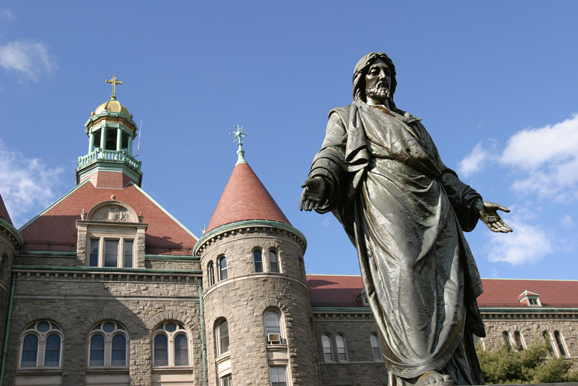by Dr. Patrick J. McNamara
In the summer of 1896, some 60,000 people gathered in the Dunwoodie section of Yonkers to witness the dedication of St. Joseph’s Seminary, which one visiting bishop described as “the grandest seminary building in Christendom.” To date St. Joseph’s has educated over 2,500 priests, both for the Archdiocese of New York and other dioceses. Dunwoodie (as it is popularly known) was the fifth (and most successful) attempt by New York Bishops to establish a stable program for priestly formation.
During the 1830s, New York’s Bishop John Dubois made two attempts to establish seminaries, first at Nyack and later at Lafargeville. These were short-lived experiments, far from the heart of the city and plagued by a plethora of challenges that included poor facilities as well as local anti-Catholic hostility.
In the summer of 1840, Dubois’ successor, Bishop (later Archbishop) John Hughes, founded St. Joseph’s Seminary on the present-day Fordham University campus in the Bronx. (The seminary building still stands on the campus as Queen’s Court, adjacent to the university church.) It started with 14 students. At first they were taught by Italian Vincentians, and later by French Jesuits. The seminary, which lasted for 20 years, educated priests for the New York Diocese, which until 1847 covered all of New York State as well as northern New Jersey.
Archbishop Hughes wanted to have his own priests, rather than religious orders, run the Fordham seminary. But lacking the personnel and the facilities with which to realize this hope, he decided to start a seminary in which all dioceses of the New York Province would collaborate. In 1864, a 40-acre campus in Troy which had formerly housed a Methodist university was purchased for St. Joseph’s Provincial Seminary. It opened that September, toward the end of the Civil War, with 70 students.
Over the next 32 years, it would ordain over 1,000 priests for New York dioceses. But living conditions were so poor that many students died early of tuberculosis.
When Michael A. Corrigan became Archbishop of New York (1885-1902), he was determined to found a new seminary that would have modern facilities and a healthier environment. He also wanted a seminary campus closer to the City of New York. In 1891, he laid the cornerstone for what would become St. Joseph’s, Dunwoodie. It would become the major theologate for the Archdiocese of New York.
Throughout its history, however, the student body at Dunwoodie has never been confined exclusively to New York seminarians. During the early years, the Brooklyn Diocese sent many seminarians there. Through the years, so have many dioceses from New Jersey, upstate New York, and the Midwest.
By the early 1890s, other dioceses had opened their own seminaries, but the facilities were never sufficient to attract the growing numbers of priestly vocations. In 1891, Brooklyn’s Bishop John Loughlin (1853-1891) founded St. John’s Seminary in Bedford-Stuyvesant, which the Vincentian Fathers staffed. By the time of its closing in 1932, St. John’s had educated over 400 Brooklyn priests.
At one time, Brooklyn had students in ten different seminaries. Like Archbishop Hughes, Brooklyn’s Archbishop Thomas E. Molloy (1921-1956) envisioned a seminary run by his own clergy. In March 1924, he purchased a 200-acre estate at Lloyd’s Harbor in Suffolk County that would develop into the Seminary of the Immaculate Conception. Dedicated in October 1930, the Huntington seminary would ordain well over 1,500 priests for Brooklyn and Rockville Centre, as well as for other dioceses and orders.
During the 1990s, the Vincentians began to send their Theology students to Huntington, while some members of the community joined the faculty.
Since the Second Vatican Council, the mission of the seminary has actually expanded. Both Huntington and Dunwoodie encompass a wide variety of activities and ministries: the Vocation Office, the Permanent Diaconate Office, diocesan Archives, to name a few. Both at Huntington and Dunwoodie, significant programs for continuing theological education for laity (as well as clergy and religious) are offered and will continue to be offered. In more recent years, several religious communities have sent their students to Dunwoodie, most notably Father Benedict Groeschel’s Franciscan Friars of the Renewal.
Through the years, Bishops have sought to respond positively and effectively to the challenge of priestly formation. Today the Bishops of New York, Brooklyn, and Rockville Centre have combined to address this challenge by combining the two theologates into one building that will continue to serve several dioceses and orders.
This should not be seen as a response to a “vocations crisis.” In fact, Georgetown’s Center for Applied Research in the Apostolate (CARA) recently noted that the number of seminarians is actually on the rise, and is the highest it has been in the last 20 years. The goal is to provide the most stable, positive and solid program for young men aspiring to the priesthood. The hopes, traditions and begun at Huntington and Dunwoodie promise to remain in place. By celebrating their respective (and collective) pasts, therefore, we celebrate the accomplishments of the past and look forward to those of the future. [hr]
Dr. McNamara, a parishioner at St. Francis of Assisi, Astoria, teaches Church History at St. Joseph’s Seminary, Dunwoodie.

